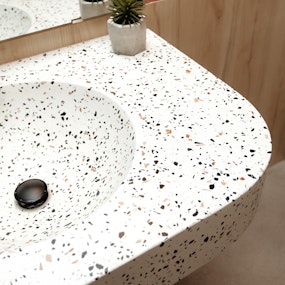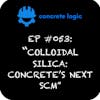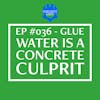EP #082: The Art of Concrete
In this episode, Seth interviews Simon Tippel from Phoenix Concrete Works. Simon specializes in decorative concrete, including countertops, fire bowls, wall claddings, and more. They discuss the advantages of concrete countertops over other materials, such as customization and flexibility.
Simon also explains the different reinforcement and technologies used in his work, including glass fiber and post-tensioning. They touch on the importance of precast vs. cast-in-place methods and the various sealers and coatings used to protect concrete countertops. Simon shares examples of other concrete products he creates, such as shower panels and furniture.
Takeaways
• Concrete countertops offer customization and flexibility, allowing for unique designs and finishes.
• Glass fiber reinforcement and post-tensioning are commonly used in decorative concrete.
• Precast concrete countertops provide better quality control and minimize mess during installation.
• Sealers penetrate the concrete and become part of the structure, while coatings provide a protective layer on top.
• Concrete can be used to create a wide range of products, including shower panels, sinks, and furniture.
Chapters
00:00 Introduction and Podcast Format
02:34 Introduction to Simon's Work
03:11 Advantages of Concrete Countertops
05:15 Customization and Flexibility
08:18 Concrete that Looks Like Wood
10:00 Reinforcement and Technologies Used
13:06 Precast vs. Cast-in-Place
14:51 Sealers and Coatings for Concrete Countertops
23:18 Other Concrete Products: Shower Panels, Sinks, Furniture
30:34 Flexibility and Artistic Possibilities of Concrete
35:00 Contact
***
Did you learn something from this episode? If so, please consider donating to the show to help us continue to provide high-quality content for the concrete industry.
Donate here: https://www.concretelogicpodcast.com/support/
***
Episode References
Guest: Simon Tippel | Phoenix Concrete Works | Simon@PhoenixConcreteWorks.com
Guest Website: http://Phoenixconcreteworks.com
Producers: Jodi Tandett
Donate & Become a Producer: https://www.concretelogicpodcast.com/support/
Music: Mike Dunton | https://www.mikeduntonmusic.com | mikeduntonmusic@gmail.com | Instagram @Mike_Dunton
Host: Seth Tandett, seth@concretelogicpodcast.com
Host LinkedIn: https://www.linkedin.com/in/seth-tandett/
Website: https://www.concretelogicpodcast.com/
LinkedIn: https://www.linkedin.com/company/concrete-logic-podcast
[00:00:00] Seth: Welcome to another episode of the Concrete Logic podcast. And today I have Simon Tipple with Phoenix Concrete Works all the way from Alberta, Canada. Simon, thanks for coming on the show today. Before we get started, I'll go through my little spiel that I always go through. But the way this podcast works is it's a value for value podcast.
So if you get some value out of this podcast today, there's three ways you can help the podcast out. One is. Don't be selfish. If you learn something from Simon today, share with the colleague, coworker, or somebody in the industry. Second thing is you could go to the concrete logic podcast.
com website. And there's a couple of ways you can get ahold of me. There's a contact button on there, which will send me an email, or there's a little microphone in homepage. You can click on that. And that will leave me a voicemail. You can just talk in there and leave me a message. And what I'm looking for is topic suggestions or guest suggestions for the show.
So if I'm overlooking something and you're like listening to the podcast and you're thinking, hey, I wish Seth would interview a certain person or go over a certain topic. That's what I'm looking for. So you can help me out there. And then the last way is on that homepage again, on ConcreteLogicPodcast.com upper right hand corner, there's a blue button that says donate. So that allows you to send some money my way to help with the cost of the podcast. There's hardware, software, all kinds of costs associated with running a podcast. So it's not free. So any dollar amount you can send over to me is appreciated.
And the folks that do donate to the show are listed as a producer for the next episode that is released. So if you go to the show notes on every podcast episode, you'll see down there, there's a list of producers. That's what that is. That's the one that's donated to the show. So with that, Simon.
Let's talk about what you do for a living. So Simon does Simon, can you just share what you do? What you do for a living? Cause we haven't talked about this on the podcast, and we've done over 80 episodes now. And we haven't talked about what Simon does. Simon, could you share?
[00:02:17] Simon Tippel: , we're in the decorative concrete industry, but not the decorative concrete industry That most people are familiar with.
So we'll do things like concrete countertops, fire bowls, wall claddings, water features in stuff that generally gets brought into your house. We do concrete furniture. And types of decorative concrete that is a little bit different from stuff that you would see, which would be things like stamped concrete or that type of thing that you will see or even carved concrete.
So that's where we're at.
[00:02:50] Seth: . So you guys. Compete with when I think of countertops and stuff, a lot of folks like granite or marble and things like that. Why do you find that people prefer the concrete countertops over those two products?
[00:03:03] Simon Tippel: It's just a different media.
I think that a lot of people are tired of pieces that you'll see a lot of quartz countertops and you'll see a lot of stuff. Everything has that kind of a plastic feel to it. Or not necessarily the granites, but people want something that's more authentic. I think people are getting back into stuff that is more artisan or in style I think it takes a special kind of person that wants to have concrete in their house.
But a lot of the, a lot of the preconceived ideas of concrete is that it's the sidewalk out front or the bridge that you drove over. But we can do so many beautiful things with concrete. That it's actually really remarkable the looks that we can achieve with that. We can do stuff that looks very similar to a natural stone.
We can have it look honed or finished so that it resembles a terrazzo floor. We can do things that are making it so it's just a salt and pepper finish, like you would have in a concrete or just have the natural raw concrete as a look.
. . So you got it sounds like it can be more customized.
[00:04:13] Seth: And if someone said, hey, I want a granite countertop, you, then you got to go to always see those places. I drive by, there's a couple of places near, near where I live, but you drive by and there's just slabs and slabs of the granite laying up there. And people, go through there. I don't have granite countertops.
I have granite. Of course, I have concrete countertops, which I've shared with the folks on the show before. And I was before I hit record. I was sharing with Simon. I was like, I wish I'd talked to you before I did that. I know I'm gonna learn something today that could have saved me some probably sometime and some frustrations.
But anyways, so going back to the granite countertops, which are very popular in our area is there's like slabs of it. And so you got to go and pick it. Certain color or whatever look that you want, and then they cut it and then bring it out to your house. And it sounds Simon, that if, You guys have a little bit more flexibility if someone says, hey, I want to, a certain look in my house, you can actually go in the house and see what they're, the rest of the decorations or whatever.
I'm not an interior designer, Simon, so you're going to have to help me out.
[00:05:21] Simon Tippel: , you betcha. So in, in a situation like we're talking about picking a slab, we actually worked with a few customers that wanted to have veining. In there they looked at a couple of slabs, but they were very specific in what they wanted to have.
For veining, they wanted to have they're like, what we'd really like is we'd like to have a piece of. Of sandstone as our countertop. A sandstone is a really weak media, but they like the look of sandstone. So they wanted to have that, but they wanted to have the fissures in that and the look of sandstone and our client was like, what would be really cool is if the vein met at the corner of the sink here and then carried on through the other, like we couldn't find that in a natural setting if we tried, how many slabs would you have to cut to find a vein that went exactly through where. The sink hole was in, in terms of what she wanted. And then she's and I'd really like the other side that, look a certain way, and I would love to have a vein pop over there. We were able to map all that out on the countertop and create those looks to those very specific locations in her kitchen so that she could have the finished look that she wanted.
So we can do some stuff that's very precise. And not look like it's very precise. We made those look very natural. And it looked pretty much like a sandstone countertop, which would be very impractical, had all the durability of what we create.
[00:06:49] Seth: , when you start talking about that, that reminded me, there's some folks I follow on LinkedIn that do casted likes like what you do, casted bowls and countertops and things.
And what some of the cool stuff that I've seen is, like you said, that you can make concrete look like a different material. Like the thing that popped up in my head when you were talking about that was, I've seen guys do concrete that looks like wood. So that's been stained. It's got the, it's got the little, wood look to it, but it's made out of concrete, which is more resilient to, things that would happen in those certain rooms.
If it's in a bathroom, it's gonna get wet. So you would rather concrete. Have something concrete get wet and versus having a wood in there. Wood doesn't do so well when it gets wet. Typically. .
[00:07:37] Simon Tippel: We've done several pieces in exactly that fashion so that they resemble. Wood. And we've even done acid staining, which is another thing that you'll see in a decorative concrete world.
I don't do a lot of acid staining, but we did some staining and some dying of products. To get the look that the person was looking for so they could have a wood look in order to have it over top of their mantle where they need to have a fire rating that you couldn't get obviously with cause they had a wood burning stove and they couldn't, they wanted that wood look, but couldn't get that wood look without compromising their fire rating.
So we were able to help them achieve that by making a natural wood look using concrete.
[00:08:19] Seth: I guess to relate to most of our listeners, most of our listeners are in the commercial concrete world. Like I do for a living, but so we were talking a little bit before we hit record about some of the technologies that we both use that overlap. Can you talk a little bit about the type of technologies you use? For instance, what's the different reinforcements you guys use for what you do? How does that work? Maybe talk about a little bit if you use any kind of ad mixtures or anything that helps.
Helps you all do, deliver
[00:08:56] Simon Tippel: a product. Certainly. So in terms of reinforcement our primary reinforcement is glass fiber, and the majority of stuff that I create is a GFRC or a glass fiber reinforced concrete as far as I know, that part of the industry in the commercial world, got its start in.
The skyscraper industry, so they wanted to make wall claddings and stuff that you could adhere to the side of a skyscraper, but they needed to do that in a way that you could cure the concrete, deliver the concrete and go up and attach and affix that in a short amount of time. And there's not a lot of tensile strength in concrete.
Everything in concrete is. More or less geared towards your compressive strength. So the way that they got around that is it's not practical. To try and put a rebar matrix or a mesh matrix in, or wire mesh matrix into such a thin panel. So they came up with using alkali resistant glass in order to do that.
That's not to say that we don't use rebar or similar types of. Reinforcement in our concrete. There's occasions where I've used rebar and whatever. Something I hadn't mentioned is in the longer pieces that we do I've got a couple of projects coming up in the summertime here that we'll be using post tension, and we can use post tension.
I think you guys abbreviate it to PT in our concrete. So we can use a post tension concrete that is slightly modified from what you might see in the industry in order to do or achieve the looks that we're looking. So we can have a, say, a table. That spans 12 feet and only have support on 2 ends. If you wanted to do a conference table or something that's decorative outside a bridge, if you're doing just a bridge and a parkway, and you just wanted to have that just craned in, we can do that type of decorative concrete without having to have the massive undertaking that, you'd have to do it with construction.
We could precast a small walk bridge and drop it into place over top of a small creek or something to that effect if we wanted to do that type of concrete, but it's certainly more resilient than people think in terms of what can be done with the decorative side of it.
[00:11:25] Seth: So what's the it the post tension is it obviously it's a much thinner cable than I've used in the past for a structural deck.
So is it like how small is that? How's that work? Can you talk a little bit more about that?
[00:11:42] Simon Tippel: I can't say a whole lot. Cause the guys that I've bound by hey, we're not supposed to talk about what we learned in a setting, but what we'll do is it's essentially, we'll put a piece of rod in the middle.
It'll be about a half inch or even a quarter inch stick in the middle of a piece of wood. A pipe that's the same diameter on the inside and then thread that through so we can compress it. So it wouldn't be a cable. It'd be more of a rod or something to that amount. I think a high tensile strength rod.
[00:12:13] Seth: Okay. And you were , we. I was sharing with you when I did my concrete countertops that I actually casted them in place. And you were saying that most of your work, like you're explaining now is precast and I don't think a whole lot of people understand that you actually cast these things and then bring it to your site where you're installing.
[00:12:35] Simon Tippel: Yes, so what we'll do go ahead.
[00:12:38] Seth: I was going to ask you, could you talk about why you do that? As far as the, I assume it's there's quality control things that are easier for you to handle when you do the precast, and, probably different ways of how you actually mix your, your concrete.
Do you guys call it concrete, by the way, because it's concrete. All right. I know when I was talking to you, HPC guy, he was like, it's composites. It's not a, it's not concrete. That's why I mentioned that. So can you talk about why you guys precast versus. Cast in place typically. .
[00:13:12] Simon Tippel: . I'm the big things are quality control. Everything in a shop environment, everything that is in my shop environment is much higher control than what we would have in a person's house. We've done a couple small pieces in place where we've done a couple pieces where, we've got to do a piece that's around a post that we can't obviously drop the concrete over top of a post.
We can't just cut the middle of the post, put that in. Those are the rare instances where we'll do a cast in place. But you've got environmental issues that you might want to can take into considerations. If you've got other trades coming in and going, because what we're doing is very decorative if you cast a piece outside a sidewalk and a catwalk through it that's concrete on the outside, right?
Nobody's going to worry about that. If you had a catwalk through your concrete while you were, Okay. That piece was in the house that might not be acceptable to the homeowner. So you have those environmental controls that you can take into consideration. And the other side of it is I don't like to leave a mess in the clients.
place. All that mess is relegated to the shop area where I'm working. So if I've got to do any polishing or processing that requires water, if I'm doing any grinding that's going to create a small amount of dust that's all contained into my shop environment and it's not in the client's area.
[00:14:36] Seth: Do you have any limitations on size when you do it that way?
[00:14:41] Simon Tippel: We've the largest piece that I've personally cast. And I know a couple of guys who have cast longer pieces than I have is we did a piece that was 17 and a half feet long, and we were able to deliver that as a 17 and a half foot long single span concrete countertop that was an inch and a quarter thick with a.
Two holes that were cut out the middle or were actually cast out. We didn't even, we didn't even cut them out. We just left voids for the sink and for their range. And we were able to bring that in a single span through the door and set it onto their countertops. We can do some really long spans.
I know a couple of guys who've done 20 plus feet in, in a single span piece of concrete. ,
[00:15:30] Seth: That's a big piece.
[00:15:31] Simon Tippel: , it's I joke about it with some of the clients. It's I'm delivering a sidewalk and setting it on your cabinets, it's , there's some monster pieces we've done monster to us.
Or like a piece like that might weigh a thousand pounds and that's not even your first three wheelbarrows off the truck, right? It's, but it's monster and you consider what we're doing with it.
, you're putting it in somebody's kitchen.
[00:15:55] Seth: That's amazing.
What do you guys typically put on the counters? Sealer or what, whatever you put on typically. So folks can use it like, any other countertops.
[00:16:06] Simon Tippel: Let's break that down into two categories. There's sealers, which is not what I think you did.
And there's coatings. So I think that in, in, the way that I think about it is there's two different technologies at play here. So a sealer, in my mind, is something that soaks down into the concrete and physically seals the concrete and becomes part of the structure of the concrete. And there is coatings, which essentially go over the top of the concrete and coat it from the top.
If you are using a urethane or an acrylic or a poly spar or any of those types of things, or an epoxy, those are all coatings that go over the top, and you'll see that a lot in, and I think that word gets misused in the industry a lot. You can get a, you can do a beautiful epoxy coating.
You can get a beautiful look. And that's great for what you're doing, and it's fine. It works really well. But if you're taking it to the next level in terms of the longevity of the lifespan of the concrete, if you're using a coating in a kitchen and you're using your knives or something and you scratch through that coating, then you have nothing that's actually protecting the concrete itself.
Whereas a sealer, the types of things that we're using, penetrate into the concrete and become part of and the sealer that I'm using reacts. It's a reactive sealer with different technologies on board that reacts with the concrete to make a glass like surface on the surface of the concrete and impregnate the concrete.
So it's a little bit different, but it gives it So if you, I don't recommend obviously cutting on top of a, on a top of a countertop or your piece, but it will make it so that the piece patinas with age versus, having to scrape a coating off and starting again.
[00:18:02] Seth: . Do you have to maintain that sealer over time or what's the maintenance on something like that?
[00:18:08] Simon Tippel: Typically it'll last you years and years, depending on abuse and Circumstances, but it may need a refresher if it's in a high traffic area after 3 to 5 years, depending on how much and a lot of that is dependent on client care. If a client is. I'll say abusive of their client of their area, then, we might even steer people away from even using us.
If they're the type of client, you can, if you, if I do a client meet, and I see that they're, the type of person that leaves a spaghetti pot in the sink for six weeks on end and pile stuff on top concrete may not be the best choice for them in that case. I would recommend, hey, get a plastic countertop or something that you're, if you're not going to maintain or keep your house or business clean, it may not be the best fit for you.
But, if you're a conscientious, you got to think, right? From a person buying a concrete countertop from us or buying a product from us, it's a significant investment into their space. So typically, they're going to want to take care of it. If they're buying a utilitarian works off and they're going to mistreat it, then it doesn't make a difference.
So we sell it to that kind of aspect, right? Prequalify our customers a little bit to say, Hey, maybe concrete's good for you. Maybe concrete's not good for you, but in a typical situation, it might be five, 10, 15 years or longer.
. You mentioned Earlier that you countertops and sink bowls and furniture you've casted for clients.
[00:19:41] Seth: Is there any other type of products that you work on, or clients ask for that maybe folks don't know that it's concrete or don't realize that you like someone like you would do? ,
[00:19:55] Simon Tippel: right now I'm working with a tiny house builder, Fritz tiny. And what we're doing for them is on all of their tiny homes right now, we're doing shower panels.
So we're doing a large format tiles. That are made in concrete. I've got a concrete tile that I have to cast after the show here. That is going to be 42 square feet and that 42 square foot countertop will weigh 210 pounds and only be a half inch thick. So in terms of tile that size, you're looking at 7 by 7 in size.
You're looking at a fairly large tile that you know, in other concrete. So we're using a very high performance mix, but in a street concrete or something in a half inch, I don't know that you would even try and cast anything that thin with the concretes that you use. And I will flip that piece 15 hours after I cast it, and I won't worry about breakage or anything like that.
It'll be a, it'll be a salt of the earth piece when we're done.
[00:21:07] Seth: Oh, wow. What the form that you use, is it wood or is it a mold or what are you using for that project?
[00:21:15] Simon Tippel: So on that particular project, I've got a casting table. So what a casting table is it can be a number of different things for different people.
My casting table is a large flat surface that we made using plywood and wood as the base. And then what I did over the top of was I put an epoxy top and then we use a Release agent so that we can pop it off the top of the epoxy so that we can get it to make those large pieces and then have a single span where we don't have any seams or joints noticeable.
Other casting tables people use, they'll use steel so you can get large sheets of steel again, waxing and sealing those and cast on top of that. And for any homeowners or anybody who's listening and wants to try it for themselves Melamine. Plywood or melamine that you would have like your kitchens are made out of that melamine surface is a really good Surface to cast over the top of if you want to Do a cast and then pop it off the surface.
[00:22:19] Seth: , that's what I did. I just popped off the laminate , I've been used as before
[00:22:24] Simon Tippel: , it works beautifully. Typically on a on one of those If you're using a melamine, you don't need to use a release agent. It doesn't stick to concrete. You can cast on top of like fiber.
No, sorry. Like poly you can cast on top of Oh, what is the word for it? Plexiglass. Oh, . You could cast on top of something like that. And the interesting characteristics about concrete, and depending on what you want, you're going to get a mirror image of whatever you cast over the top of.
Providing you have a release agent or whatever. So if you were doing a decorative piece on your own or whatever, you could cast over top a piece of glass and it'll have that same sheen on the concrete side as the glass, right? It'll have that shine or whatever. It's not a durable finish because it's a cream finish.
But, if we talked about those board form earlier where they wanted to have it look like wood, if you cast on wood, it'll look like what just the reverse of whatever you were casting on. .
[00:23:19] Seth: Did the, that piece you're talking about the project you're working on. That's only a half inch thick and it's 42 square feet.
What is that the glass you're using glass fibers as reinforcement for that project? ,
[00:23:33] Simon Tippel: I'm using half inch glass fibers. Typically That's all I use. I know a lot of guys will use scrim. I don't know if you guys have any idea of what scrim would be. Scrim is a mesh that is applied to the area that you want to have if you need extra reinforcement in a concrete, I won't go too much into detail, but it's another backing something that would be similar.
You might see it is scrim or a version of scrim might be used in stucco. You might see them put it on the wall and go over the top is a. Reinforcement on that area, but typically I don't use scrim anymore because the concrete has gotten such good quality or such a high quality in the last couple of years that I don't feel that it's necessary anymore.
[00:24:23] Seth: The reinforcement I use for my countertops was, it was a carbon fiber mesh. So the it felt like almost like a, like twine almost is the best way I can describe it. A net twine. Okay. And then you have to attach it to the chairs, so you put the chairs in the, oh, I'm following.
[00:24:44] Simon Tippel: Yes. , I guess that would be a. Potentially a version of scrim and you put it, it's basically in your situation, it would have been the underside of the countertop almost. . .
[00:24:55] Seth: So you put the, , I screwed the, these plastic chairs in there and then attach the carbon fiber. Mesh to that, so it wouldn't float when I was placing the concrete.
[00:25:09] Simon Tippel: , that would probably be more of a scrim. And in that case, I guess we can talk a little bit about it since you brought it up here. In most cases, you want that on the bottom side of your concrete. So if you were going over a span, that is to help with the tension side of the concrete, right?
Typically if you're doing a span over a certain spot, like if you were spamming two pieces and the. The force was going from the middle downwards. You want the bottom to have your attention tension for reinforcement. If you were doing a cantilever, you'd want that piece on the top side so that your piece isn't going to snap off on the other way.
If you're, if you had a large cantilever in your counter and you had that mesh on the bottom. And you had a cantilever, the piece might snap off more if, unless you had that on the top half of the concrete, if that makes sense.
[00:26:01] Seth: , no, . , that's hopefully I did that I guess I'll find, time will tell me if I get, get cracks, right?
. Oh, good. Is so there's the tile, the shower panel. Are there any other favorites out there that you want to share before we wrap it up today? Any other projects you're working on or past projects that you,
[00:26:22] Simon Tippel: I know that in certain building applications a big 1 for us is we'll do concrete sinks.
And we'll do a concrete sink. A lot of our commercial jobs end up being the concrete sinks because they have to be ADA compliant. I don't know what I'm pretty sure the ADA compliancy in the United States is the same as they're in Canada. ADA compliancy is your disability accessibility kind of thing.
. So they have very strict guidelines to what can be produced in terms of accessibility. Typically they have to be to the very bottom of a sink. You cannot be lower than 29 inches, and they cannot be taller than 34 inches. So you have that five-inch band that they're saying that is the height requirement for a sink.
[00:27:10] Simon Tippel: And in. A lot of applications, if you go into places, you'll see that's the way that most of those places are. But the creativity that we can do with concrete, we can create like a sink. That's 14 feet long. So you can have multiple wash. Stations at it and make it at least aesthetically pleasing a lot of those things that you'll see in a lot of those places.
If they're not made out of concrete, they're made out of plastic or Corian or stainless steel, but they're not. They're not really a decorative item. So they're utilitarian. And what we can do is we create pieces that are much more artisan and I appealing in those types of cases, we've done a few shower bases, a few bathtubs.
There's a lot of places where you can use concrete decoratively that that people might not even be aware.
[00:27:58] Seth: , it gives you the flexibility to, pretty much come up with what you want really, it sounds and then you get, you could cast it to whatever the customer really wants, instead of having to say, Hey, I got this slab of.
Quartz or slab of granite that you got to work with to make it happen or steel or whatever. I think you got more flexibility using concrete and plus concrete is just cool.
[00:28:26] Simon Tippel: And another thing to consider when you're using concrete a lot of the pieces, like we're talking about casting fairly thin pieces of concrete.
And weight is always a factor in what people. Take a look at, but you can do furniture pieces. We're going to be making a couple of chairs coming up. And those chairs are going to be kitchen chairs. So we can do thin, thinner pieces than what people think. A lot of people think that, coffee needs to be 4 inches thick or whatever.
We can cast some very thin pieces and the flow ability of what we're using for our mix is in such a way that you know, . Those half inch, three quarter inch type pieces are absolutely possible. And if we can build a mold that the concrete can flow through, we can design some pieces that are mind bending in, and there's some artisans out there that are doing some phenomenal stuff.
With furniture that you wouldn't have dreamed of doing even five or six years ago because the media has gotten to a point where if you can imagine it, you can probably cast it. .
[00:29:26] Seth: Yes. There's some cool stuff out there. Definitely. I think this is a good spot to pause today, Simon, if folks want to reach out to you and learn more about what you're doing.
It sounds like you're. You're on the cutting edge of some of this stuff. So there might be some listeners out there that want to learn more. What's the best way to get ahold of you?
[00:29:48] Simon Tippel: Because we're up in Canada the probably the easiest way for most of your listeners is just to reach out and find us on Instagram.
We're at Phoenix Concrete Works on Instagram is probably the easiest place that you'll be able to find me. And or you can reach out by email and that's Simon at Phoenix concrete works dot com. ,
[00:30:06] Seth: that's great. And we'll put all Simon's contact information in the show notes. So folks can find it there as well.
And then Simon's podcast will have its own page on the website. So you'll want to check that out. All right, Simon. Appreciate you coming on the show. Everybody until next time. Let's keep it concrete.

Simon Tippel
Concrete Artisan
Owner of Phoenix Concrete Works
I picked the name Phoenix as it pertains to the mythological bird.Rome itself saw it as symbol of Rebirth and Learning as well as other cultures like the Greek and Chinese.
Despite lots of Cultures having a form of Concrete in the past. Portland Concrete technology is still evolving and I find that interesting. When Roman Concrete can survive being submerged in Sea water and a great deal of modern concrete crumbles, it's interesting to think it has taken Nearly 2000 years to make something comparable.


















